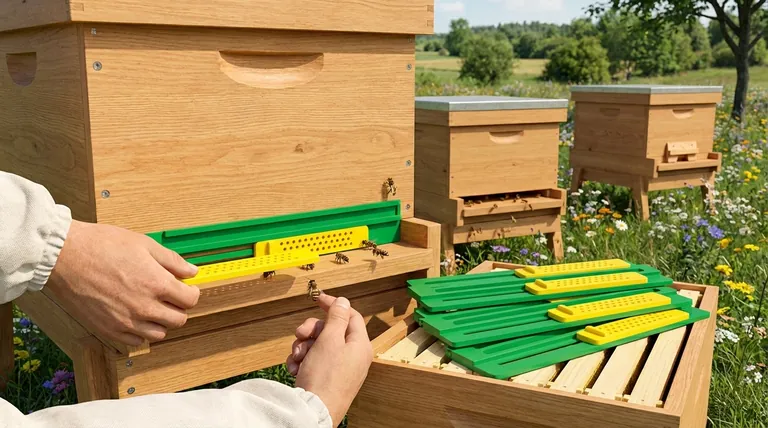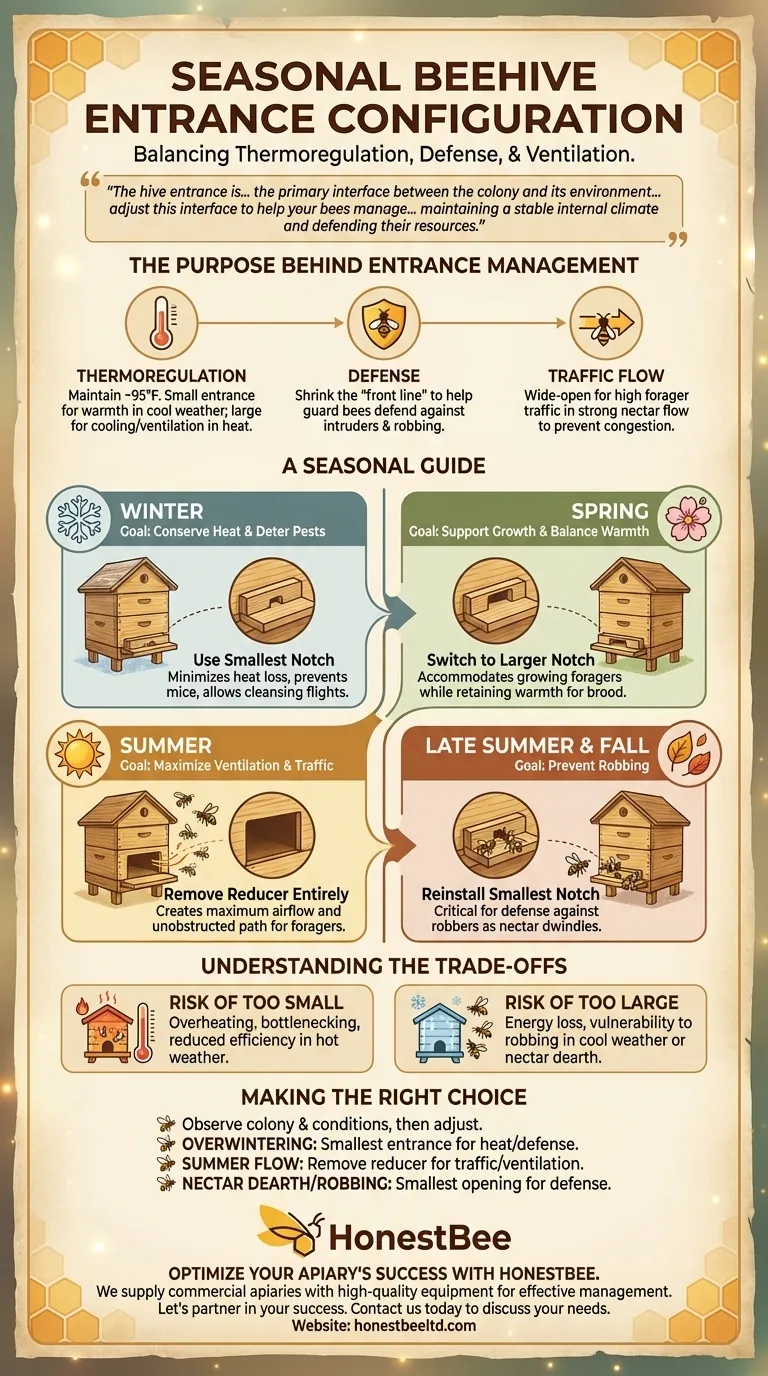At its core, seasonal beehive entrance configuration is a balancing act between the colony's need for thermoregulation, defense, and ventilation. Beekeepers use an entrance reducer—a small block of wood with different sized notches—to adjust the hive opening. In winter, the smallest opening is used to conserve heat and deter pests, while in the peak of summer, the entrance is often left fully open to maximize airflow and accommodate heavy forager traffic.
The hive entrance is not merely a doorway; it is the primary interface between the colony and its environment. Your goal is not to follow a rigid calendar, but to adjust this interface to help your bees manage their two greatest challenges: maintaining a stable internal climate and defending their resources.

The Purpose Behind Entrance Management
A hive's entrance directly impacts its ability to function. The size of the opening dictates how easily the colony can control temperature, defend against intruders, and manage the flow of foragers.
The Goal of Thermoregulation
Honey bees work constantly to maintain the brood nest at a stable temperature, typically around 95°F (35°C).
A smaller entrance in cool weather reduces the volume of cold air entering the hive, making it easier for the bees to generate and conserve heat. A larger entrance in hot weather allows for better ventilation, helping the bees cool the hive through fanning and evaporation.
The Goal of Defense
A large, undefended entrance is an open invitation to predators and robbing honey bees from other colonies.
By reducing the entrance size, you shrink the "front line" that the guard bees must defend. This is especially critical for smaller colonies or during a nectar dearth, a period when natural forage is scarce and stronger colonies may try to steal weaker hives' honey stores.
The Goal of Traffic Flow
During a strong nectar flow, thousands of foragers will be entering and exiting the hive every minute.
A wide-open entrance prevents traffic jams, allowing foragers to work more efficiently. A congested entrance can slow down foraging operations and reduce the colony's overall productivity.
A Seasonal Guide to Entrance Configuration
While you should always respond to your specific hive's condition, this seasonal framework provides a reliable starting point.
Winter: Conserving Heat
The primary goal in winter is to help the colony stay warm with minimal effort.
Use the smallest notch on your entrance reducer. This minimizes heat loss and prevents mice from seeking shelter inside the hive while still allowing for cleansing flights on warmer days.
Spring: Supporting Growth
As the queen ramps up egg-laying, the colony needs a balance between retaining warmth for the new brood and accommodating a growing number of foragers.
Once temperatures are consistently above freezing and bees are flying regularly, switch to the larger notch on the reducer. This provides more space for traffic without creating a major draft.
Summer: Maximizing Productivity and Ventilation
During the peak of the season—hot weather and a strong nectar flow—the priority shifts to cooling and efficiency.
Remove the entrance reducer entirely. This creates maximum airflow to help the bees cool the hive and provides an unobstructed path for the high volume of forager traffic.
Late Summer & Fall: Preventing Robbing
This is the most critical time for defensive entrance management. As nectar sources dwindle, robbing behavior intensifies.
Reinstall the entrance reducer to the smallest opening. Even strong colonies can be overwhelmed by robbers, and a small entrance is their single best defense.
Understanding the Trade-offs
Every adjustment you make has a consequence. Understanding the potential downsides is key to making the right decision.
The Risk of an Entrance That's Too Small
In hot weather or during a heavy nectar flow, an overly restricted entrance can cause the hive to overheat. It also creates a bottleneck, reducing foraging efficiency and frustrating the colony.
The Risk of an Entrance That's Too Large
In cool weather, a wide-open entrance forces the bees to expend precious energy and resources just to keep the brood warm. For a weak hive, it makes them highly vulnerable to being robbed out by stronger colonies.
The Myth of a "One-Size-Fits-All" Approach
Never manage your entrance based solely on the calendar. Pay attention to the bees. Is there bearding on the front of the hive? They may need more ventilation. Is there fighting at the entrance? They need a smaller, more defensible opening immediately.
Making the Right Choice for Your Hive
Observe your colony's behavior and local conditions, then adjust the entrance to support their immediate needs.
- If your primary focus is overwintering a new or small colony: Use the smallest entrance to help them conserve heat and defend their limited stores.
- If your primary focus is maximizing a strong colony's summer honey flow: Remove the entrance reducer entirely to facilitate heavy forager traffic and improve ventilation.
- If you are experiencing a nectar dearth or notice fighting at the entrance: Immediately reduce the entrance to the smallest opening to help the guard bees defend against robbers.
By managing the entrance thoughtfully, you transition from simply keeping bees to actively partnering with them in their success.
Summary Table:
| Season | Primary Goal | Recommended Entrance Configuration |
|---|---|---|
| Winter | Conserve Heat & Deter Pests | Smallest notch on the reducer |
| Spring | Support Growth & Balance Warmth | Larger notch on the reducer |
| Summer | Maximize Ventilation & Traffic | Remove reducer entirely |
| Late Summer/Fall | Prevent Robbing | Smallest notch on the reducer |
Optimize Your Apiary's Success with HONESTBEE
Mastering seasonal hive management is crucial for the health of your colonies and the productivity of your operation. At HONESTBEE, we supply commercial apiaries and beekeeping equipment distributors with the high-quality, durable supplies needed to implement these best practices effectively. From precision entrance reducers to full hive systems, our wholesale-focused operations ensure you get the reliable equipment your business depends on.
Let's partner in your success. Contact our team today to discuss your specific needs and discover how our products can help you build stronger, more productive hives.
Visual Guide

Related Products
- Multi-Functional Sliding Hive Entrance for Beekeeping
- Multi-Functional Rotary Hive Entrance Disc for Beekeeping
- Professional Reversible Beehive Hive Entrance
- Professional Galvanized Hive Strap with Secure Locking Buckle for Beekeeping
- Endless Loop Ratchet Hive Strap
People Also Ask
- What size is the entrance hole in a native bee hive? The 13mm Standard for a Thriving Colony
- What additional functions do hive entrances serve? A Key to Colony Health, Security, and Productivity
- How does the sliding design of the entrance reducer benefit beekeepers? Achieve Ultimate Hive Control
- How can a Langstroth hive entrance be adjusted? Mimic Natural Bee Preferences for a Healthier Hive
- Why is a smaller entrance size beneficial for a beehive? Boost Hive Defense & Productivity


















